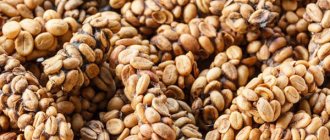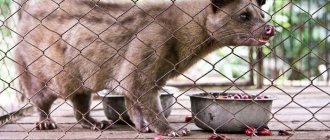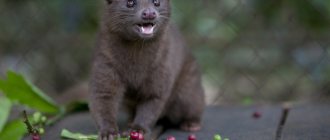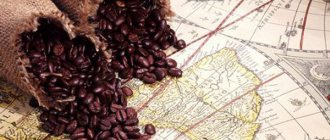A few years ago, coffee “from the feces of an Asian mammal” was heard from every media outlet. People debated the ethics of consuming unique coffee beans, and manufacturers launched heavy advertising to capitalize on the hype. But the popularity of the drink disappeared as quickly as it appeared.
What exactly is kopi luwak, why is this type of coffee one of the most expensive, and how does caffeine affect the human body?
Coffee myth: meet Kopi Luwak coffee
The same thing happens in the world of coffee. There are actually a lot of common myths and misconceptions about coffee (I'll cover these in a separate post).
But there is one misconception that is so widespread and enduring that no amount of debunking seems to help. And it is a myth that “Kopi Luwak is the best and most expensive coffee in the world.”
I can't count how many times people have asked me my opinion about Kopi Luwak. Once, I was even invited to a TV show to taste and discuss Kopi Luwak coffee.
The paradox is that it should be obvious to any sane person that we are talking about a universal delusion.
Do you really think that any food or drink will taste better if you mix it with ... um... shit ? If this is not the case, why do you think it is any different in the case of coffee?
However, it appears that about 99 percent of the world's population wants to believe the Kopi Luwak story.
I know that this probably won’t change the situation much, but I will try to put an end to this worldwide misconception and restore the true state of affairs.
Types of Coffee Plantations
There are several coffee plantations on the island.
They are divided into two types:
- Non-tourist plantations. They are located in the mountainous region of Kintamani. There, farmers have contracts with various companies to whom they supply coffee directly. There is not much for tourists to do in these places, since the plantations are closed to the public. In the mountains, mainly Arabica beans are grown. If you want to try coffee harvested in Kintamani, visit one of the coffee shops in the resort area. Coffee beans come here fresh - straight from the farms (their addresses are kept secret). Here, in the coffee shop, they are roasted and ground before your eyes and immediately turn into an aromatic drink. A 200-gram package of luwak can be purchased for $50-$60. And you can be sure that this is a real kopi luwak.
- Tourist plantations. These are small farms near the resort area in the south of the island. They are aimed at tourists, so anyone can visit them. As a rule, they will give you a tour here and organize a tasting of the drink. Unlike mountain farms, rúbusta is grown here because it does not require as much care as arabica. In addition to coffee, cloves, various spices (for example, vanilla, cinnamon, pepper, ginger), as well as cocoa and even pineapples are grown on plantations. They are mainly sold here on the island - often in kiosks right next to the plantations. Rollers, pigs, bees and wasps are also bred here.
The origin of coffee is from cat litter
To understand how Kopi Luwak achieved its popularity, we need to look a little at history. Back in the 1600s, the coffee market was completely different from what we see today. One of the main habitats was the Dutch East Indies, a group of islands now known as Indonesia.
Indonesia was one of the first countries, other than Ethiopia and Yemen, where coffee was grown on a large scale, and at some point the island of Java became almost synonymous with coffee in Europe.
But by 1830, the Dutch had adopted a series of strict rules governing agricultural relations in the colony. The ban on harvesting coffee for personal use among local farmers who were already accustomed to drinking coffee was unexpected.
Somehow, these caffeine-deprived wage workers discovered that a small cat-like animal—the palm marten, also known as the luwak—was eating coffee berries and passing the seeds through its intestines without digesting them.
The workers were not fools, and the Dutch never prohibited collecting manure.
It wasn't long before locals began harvesting, roasting and brewing coffee beans from the feces so they could satisfy their caffeine cravings.
How to cook
This coffee has a sweet caramel flavor, mixed with many other additives that depend on what the musang ate in captivity. They also give him fruits and vegetables, which also give the coffee a unique identity. But the correct preparation of such coffee is also of considerable importance:
- The pot in which to brew is warming up.
- After this, ground grains and sugar are added to taste.
- The mixture is heated, after which water is poured in - always cold - and the Turk is placed on low heat.
- Heating is carried out until foam appears so that it slowly rises to the edges of the pot.
Carefully ensure that the coffee does not run away and does not overheat. Otherwise, you can safely discard it and start cooking again.
The Vietnamese love to add condensed milk to this drink. Considering that coffee itself has a sweetish taste, adding such an ingredient may be unnecessary for a European.
There is another way to make coffee using spices, which will require:
- Ground Luwak coffee beans - three teaspoons.
- Water - no more than 250 ml.
- A pinch of cardamom, cloves, ginger.
Everything is put into a Turk, which is preheated. The mixture is kept on fire until the foam begins to rise. This is a European way of brewing unique coffee.
In Vietnam itself, the preparation of the drink is different. There is a special device that can be purchased at any supermarket or store. It consists of a cup, a fine sieve and a press. The ground coffee is placed at the bottom of the cup, a press is placed on top and hot water is poured in. Under the influence of gravity and water, the drink flows into the reservoir drop by drop.
Processing disputes
At that time, the standards for harvesting and processing coffee beans were nowhere near what we have today.
When harvesting coffee, it is very important that the berries are completely ripe . As with other fruits, this ensures that your sugar levels reach their peak.
The animals prefer ripe berries, which suggests that in the wild the palm marten would be more selective than the workers of the Dutch plantations. But this is just a guess.
The process of processing coffee, at its core, is to remove the pulp from the berries before they begin to rot.
As a matter of fact, this happens in the animal’s stomach within 30 hours.
It is quite possible that this combination of careful selection of berries and efficient processing of coffee beans from the pulp made this coffee the best available at that time. However, it is worth remembering that the accepted processing standards back then could not compare with those now used by specialty coffee producers.
Features of Kopi Luwak coffee production
In fact, the technology for processing coffee beans is not much different from the traditional one. After all, how does the production of a drink familiar to everyone take place:
- berries are picked;
- the stone is freed in a dry way - by drying it in the sun or in special machines, or wet - by rubbing the berries in a machine and washing off the pulp;
- place the grains in baths for 3-4 days for fermentation and fermentation;
- washed and dried.
And only then they fry it. And in the case of Kopi Luwak, all the manipulations are performed by this funny animal. Luwak replaces the staff of agricultural farm workers: it harvests the crop itself, removes the pulp from the grain, ferments with gastric juices and intestinal enzymes, breaks down proteins, as a result of which the drink becomes even more aromatic and tasty without the usual bitterness. The owners of the coffee plantation can only wash, dry and carefully, so as not to spoil the effect, roast the beans.
Grains before grinding, in fact - dried Luwak excrement
Start of commercialization
One of the rules of marketing is the so-called ability to turn a disadvantage into an advantage. This is exactly what happened next.
Kopi Luwak quickly attracted the attention of the colony's administrators.
It was widely believed that the coffee tasted milder than regular coffee.
For the record, when someone uses adjectives like “smooth” or “strong” to describe coffee, it will most often be a sure sign that they don’t understand anything about it.
Due to the limited supply of Kopi Luwak, it could fetch more money when exported. Yet the coffee trade did not become a big business, and as large-scale commercial coffee production began to develop in regions other than Indonesia, interest in Kopi Luwak waned.
But then something big happened in 2007: Kopi Luwak was mentioned in the movie Before He Played It Off, starring Jack Nicholson and Morgan Freeman.
Interest in it has increased again, and resourceful entrepreneurs hastened to take advantage of this craze. Overnight, coffees with Kopi Luwak on the label began appearing in Southeast Asia, even though they were nowhere near cat droppings.
With good advertising, terrible Robusta can be sold for huge sums of money to some naive tourists who will believe that they bought the best coffee in the world.
But that wasn't the worst thing. It turns out that some farmers in poor Asian coffee-producing countries have suddenly started capturing martens and force-feeding them coffee berries.
Classic cooking method
Residents of Sumatra brew the drink according to a traditional recipe:
- 1 ½ tsp. Place ultra-fine ground Luwak coffee into a well-heated ceramic container.
- Add 160 ml of boiled water, cooled to a temperature of 90 °C.
- Mix the ingredients thoroughly, cover with a saucer and let sit for no longer than 5 minutes.
This is interesting: How coffee is brewed in Vietnam
Luwak coffee producers believe that the taste of the drink is maximized when ground with powder.
From marten to monkey and elephant excrement
Martens are omnivores and feed on a variety of fruits and insects. It goes without saying that coffee berries should not be the main part of their diet, since caffeine affects animals in the same way it affects humans.
This method of producing coffee is not only idiotic, but is a clear example of animal cruelty.
Recently, similar coffee has appeared in South America and the rest of Asia. The most notorious are coffee made from monkey droppings and Black Ivory coffee, which passed through the digestive system of an elephant.
Interesting Facts
Black Ivory Coffee, or “Black Tusk”, is the name of coffee produced by enterprising Thais using the Luwak method. The elephant is fed fruits and sugar cane, adding coffee berries to its usual food, and then they follow the same scheme: they take out untreated bones from the excrement, wash them, dry them, and fry them. The resulting grains are also not bitter and are also expensive on the world market.
Kopi Chon is a coffee produced in the same way as Kopi Luwak, but in Vietnam instead of Indonesia. There is also a palm marten, but the Vietnamese call it chon, not luwak. The production scheme is no different; the cost of Kopi Chon is lower, which can be explained by insufficiently active advertising of the brand.
The high cost of Kopi Luwak is also explained by the fact that musangs do not breed in captivity, so they cannot be kept on a farm all year round and increased production at will. Indonesian farmers catch them and keep them in cages for 3 months - the time of ripening of coffee berries. And then they are released into the wild.
Luwak in captivity eats about a kilogram of coffee berries; in a daily litter there are no more than 60-70 grams of beans, which also explains the limited strategic reserve.
According to world market data, the amount of Kopi Luwak supplied annually is no more than 300 kilograms. This is a tiny amount, considering the volumes consumed by drinkers, most of whom live in the UK, Hong Kong and Japan.
The Kopi Luwak brand and coffee beans processed in musangi body are not the same thing. Experts believe that branded coffee contains only 5-10% of real beans fermented in the luwak stomach, and the rest is simply high-quality Indonesian Arabica.
Coffee suppliers buy it from farmers in a form almost ready for preparing the drink - roasted and sometimes ground. Therefore, they may not have their own processing plants - a packaging workshop is enough.
Kopi Luwak supplies in Russia are carried out by PKF BLUZ LLC, in Ukraine it is Paradise Gourmet-Club - there is no common monopolist supplier for the CIS countries or Eastern Europe. Precisely because purchases are made in small batches.
Grain quality plays an important role
In previous sections, we discussed why Kopi Luwak may have been better than any other coffee available during the colonial era, but it still does not compare to the coffee we have today.
Thinking about quality in this context can be confusing. So let's try to give a more precise definition.
When someone says, “Kopi Luwak is the best coffee in the world,” what they are really talking about is a specific type of bean processing, not a specific botanical variety.
In Southeast Asia, where Kopi Luwak originated, you can find a wide variety of coffee varieties - from high-end Arabica to low-grade Robusta - grown at different altitudes.
And while the processing process is an integral part of creating great coffee, there are other factors that are just as important.
To be fair, let's compare Kopi Luwak to other washed or natural coffees. It's funny though. No one who works professionally with coffee would ever claim that the best coffee in the world is washed coffee. This is the same as saying that the best wine is red wine. The statement is so broad as to be devoid of any meaning. The truth is that among washed coffees there are excellent and terrible examples.
Coffee made from animal feces is literally crap
My metaphysical research shows that Kopi Luwak is much worse than the average coffee. And don't even think about comparing him to Geisha.
If you look at cat feces coffee from this angle, it becomes clear that this is just a clear example of successful marketing to fool gullible consumers.
But still, isn’t it interesting to see how this type of coffee performs in comparison with other beans?
This is exactly what I did in my article about the best coffee in the world. There, in my conclusions, I tried to rely on statistics. It's immediately apparent that Kopi Luwak is actually of lower quality than the average specialty coffee. You can read more about this here.
My results are supported by the fact that none of the winners of the most prestigious coffee tournaments in the world have ever used Kopi Luwak.
Taste of Kopi Luwak
The first thing you need to pay attention to is the origin of the coffee beans. Kopi Luwak, which is produced on farms, is radically different from grains obtained from wild animals. The farm product is not as tasty, rich and healthy. Finding authentic coffee is almost impossible. Manufacturers rarely indicate the origin of the grains, and the finished product is identical in appearance. Not everyone will be able to find a quality product through trial and error, since kopi luwak is one of the most expensive varieties on the market.
Opinions differ regarding the taste of popular coffee. Some call the exorbitant price unjustified, and the drink itself is tart and impossibly bitter. Others rejoice at every opportunity to taste a cup of kopi luwak and claim that they have never seen such rich, creamy, nutty shades anywhere else. Everything affects the taste of the drink:
- the age of the musang, its way of life and even what it ate during the day;
- method of subsequent grain processing;
- storage of raw materials;
- quality of the liquid and method of preparing the drink.
Coffee lovers who still decide to try a few cups are inclined to believe that the variety is unjustifiably popular. They believe that a good advertising company has miscalculated only one thing - the product that needs to be advertised. The piquancy is inherent only in the story, and not in the taste of the drink, but it is best to see this for yourself.
So why?
How is it that this myth still exists? Well, for the same reason why Kopi Luwak made it into the movies in the first place.
This is a ready-made headline for the yellow press. It’s too funny not to chat about at the water cooler at work or share on your favorite social network.
In some ways, it's not much different from the stories of Einstein and ostriches.
How can we put an end to this stupid idea? First, you can go ahead and share this story on your social networks. Some people might be upset by this news, but if it's necessary to save animals and improve the quality of coffee tourism in Indonesia, I'll get through it somehow.
about the author
Hi, I'm Asser Christensen from Denmark, founder and editor of THE COFFEE CHRONICLER. For as long as I can remember, I have always been crazy about coffee. Today I am a licensed Q-grader and professional coffee writer.
Introduction. The difference between Arabica coffee and Robusta coffee
If you follow from Ubud from the Arjduna statue towards the north, in the direction of the large caldera, along the way you can meet a dozen coffee plantations, where local workers will tell you and show you how coffee grows and conduct its tasting.
Today we will take a look at one of the coffee plantations and look at the coffee production process.
Most of the plantations we visited are located on the slope of a ravine and are a small garden of 6-8 acres. The garden contains coffee trees, various Asian spices and some exotic fruits.
There are two types of coffee trees growing on the coffee plantations of Bali: Arabica coffee and Robusta coffee. Let's first figure out what the differences are between these trees:











